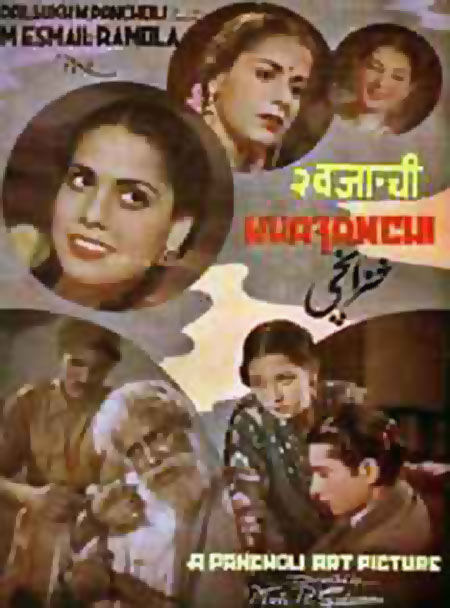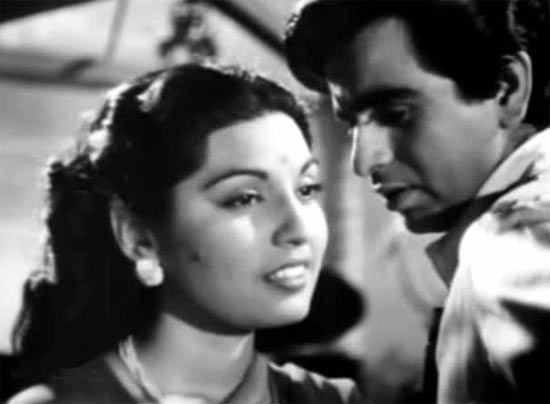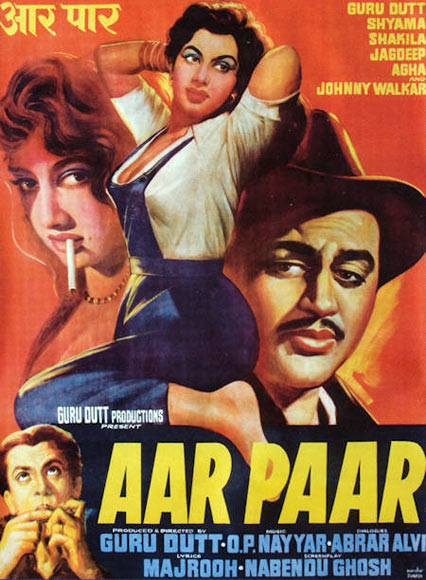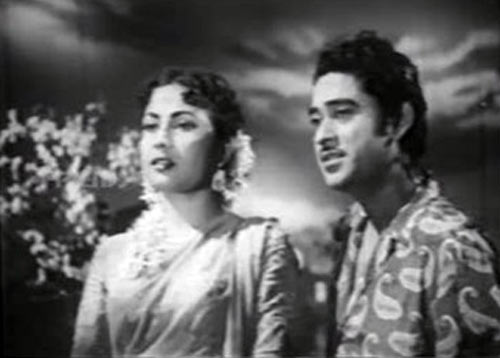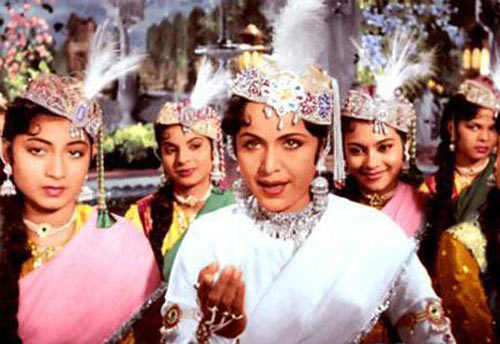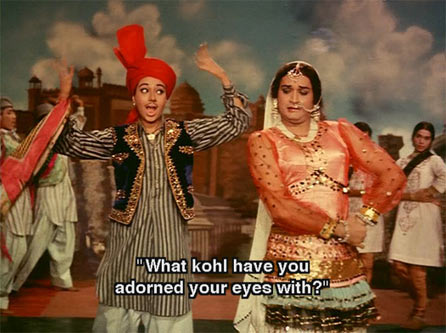This article was first published 12 years ago
Shamshad Begum's Top Ten Songs
Last updated on: April 25, 2013 18:34 IST
Image: Clockwise: Waheeda Rehman in CID, Babita and Biswajeet in Kismet, Shyama in Aar Paar and Vyjayantimala in Bahar
Legendary playback singer Shamshad Begum, who mesmerised music lovers with her classic songs,
passed away at her Mumbai residence from age-related ailments On April 23. Jitendra Kothari pays her a tribute.
Shamshad Begum's robust, piercing voice could convey emotion in its purest form. The life force coursed through her vocals as she navigated through Golden Era classics from the 1940s to the 1960s in a singing style that was distinctly, famously, her own.
News of the veteran's demise on April 23 brought rushing to my mind her penetrating lines from the climactic Mela song -- 'Dharti ko aakash pukaare ... Iss duniya ko chhod ke pyaare ... jaana hi hoga' -- which now hold a special poignance.
Here are 10 unforgettable Shamshad Begum gems in a tribute to a true talent.
Image: Poster of Khazanchi
Young Shamshad had worked with Master Ghulam Haider for radio shows, and when he composed the score for Lahore-based producer Dalsukh Pancholi's superhit film, Khazanchi, she got a chance to shine as a playback singer in Hindi films.
The peppy Sawan ke nazaare, which was picturised on leading lady Ramola riding a bicycle, became immensely popular with its cobweb-dispelling lalalalala refrain but Shamshad's voice was also employed for the film's other actress, the adolescent Manorama (yes the same wily termagant of the 1970s), sweetly articulating Ek kali naazon ki pali.
Image: Nigar Sultana in Patanga
Shamshad Begum shifted to Mumbai in 1943 and established herself as a leading playback singer. Music director C Ramchandra added a new dimension to her popularity with the goofy ditty Aana meri jaan... Sunday ke Sunday in Shehnai (1947) and followed it up with another from the same genre -- Mere Piya Gaye Rangoon in Patanga (1949).
Shamshad Begum deftly captured the humorous spirit of this droll song which is picturised as a stage show performed by heroine Nigar Sultana and the comedian Gope.
This hit film had a whole harvest of whacky, immensely catchy Shamshad songs with self revelatory titles like Gore gore mukhde pe, Boloji dil loge toh kya kya doge, O dilwale dil ka lagana achha hai ... par kabhi kabhi, Balam tujhe mera salaam, Namaste namaste and that delectable duet with Lata Mangeshkar -- Pyar ke jahan ki nirali sarkar hai.
Image: Munnawar Sultana and Dilip Kumar in Babul
Though Shamshad Begum is often remembered for her fun and frolicky frothy numbers, she also has an extensive oeuvre of songs which capture her emotional range -- from Ik tera sahara (Shama) to Kaahe koel shor (Aag) to Dharti ko aakash pukare (Mela) to her Babul songs.
Duniya badal gayee has leading lady Munnawar Sultana lamenting the hiccups in her love affair with Dilip Kumar; and Shamshad brings to her rendition a wealth of control even when conveying the anguish in a full-blooded manner.
Notice the way music director Naushad intelligently tones down the orchestration and lets her amazing voice hold sway in the line Dil khaak ho gaya yeh kisiko khabar nahin. The result is heart-rending.
Image: Vyjayantimala in Bahar
S D Burman had employed Shamshad Begum's voice to great effect in the boisterous Kamini Kaushal hit Yeh duniya roop ki chor bacha le mujhe babu (Shabnam). That is probably why he chose Shamshad Begum's rollicking vocals to match teenaged debutant Vyjayanthimala's famed twinkle toes in her first Hindi film, Bahar.
And what a fortuitous match it turned out to be in a string of dance numbers such as O pardesiya, Kusoor aapka huzoor aapka, Duniya ke maze le lo, Chhodoji chhodoji, and especially (the much remixed) Saiyan dil mein aana re, aake phir na jaana re.
Sixty years after the release of this song, Shamshad Begum's voice sounds still fresh with the exultation of incipient love. The song remains perennially popular and the singer-actress combination is sure to get your feet tapping.
Image: Poster of Aar Paar
Another Shamshad Begum song which was a popular remix, evidencing it's eternal appeal.
Music composer O P Nayyar's songs with their Punjabi inflections were well suited for Shamshad's powerhouse vocals; and even in this spectacular score, studded with unforgettable Geeta Dutt gems, he gave Shamshad an outstanding song in Kabhi aar kabhi paar laga teer-e-nazar.
Onscreen a very young Kumkum makes this pithy comment on the battle between the sexes (Guru Dutt and Shyama have a lovers spat) while behind the mike Shamshad lends her unmistakable brand of energy and mischief to lines like
Man hi man mein laddoo phoote
Nainon se phuljadiyan choote
... honthon par taqrar
Image: Waheeda Rehman in CID
Like Vyjayanthimala, another legendary actress, had Shamshad Begum sing all her songs in her hit debut film.
Waheeda Rehman may have played the vamp in CID but she made a major impact with this film.
For this, thanks is owed in no small measure to Waheeda's popular dance number Kahin pe nigahein kahin pe nishana, whose bad-girl-gone-good mystique was feelingly put over by Shamshad.
O P Nayyar lavished as many as three hit numbers on Shamshad Begum in CID. Shamshad also sang up a storm with Leke pehla pehla pyar (filmed on Sheila Vaz) and Boojh mera kya naam re (filmed on Minoo Mumtaz).
Image: Meena Kumari and Kishore Kumar in Naya Andaz
In retrospect, the combinations in this song are rather astonishing -- famed comedian Kishore Kumar romances noted tragedienne Meena Kumari onscreen (never mind the fact that they did half a dozen films together) while off screen, Shamshad Begum shares a rare duet with her junior, Kishore Kumar, to whom she is said to have been very encouraging! The dulcet result is ambrosia for the ears.
This soft focus romantic number aptly showcases Shamshad Begum's wide range. It was up to ever-adventurous composer O P Nayyar to modulate the talented singer's frothy image which he had, ironically, helped perpetuate.
Image: Nargis, Rajendra Kumar, Sunil Dutt in Mother India
Naushad had constantly collaborated with Shamshad Begum from the mid 1940s -- ever since Jab usne gesu bikhraye from Shahjehan (1946). In the late 1940s and early 1950s, he would broadly divide the female playback duties between his two favourites -- Shamshad Begum and Lata Mangeshkar. In Dulari, if Lata sang for Madhubala, Shamshad lent her voice to Geeta Bali.
If Lata was the playback singer for Nimmi in Deedar, Shamshad Begum sang for Nargis. And sometimes Naushad made both sing for the same heroine in a film (Nalini Jaywant in Jaadoo). Increasingly, however, he veered towards Lata.
But as the Mother India score evidences, he called Shamshad whenever he had fashioned a song just right for her flair for earthy folksy numbers.
Shamshad had several numbers in Mother India like Pee ke ghar aaj, Holi aayee, Dukh bhare din beete and O gaadiwale gaadi dheere haank re. The last is sung with such verve by Shamshad Begum, you can almost feel the wind blowing through your hair.
Image: Meenu Mumtaz, Nigar Sultana in Mughal-E-Azam
This classic qawwali is a bouquet of superlatives -- Naushad's music, Shakeel Badayuni's lyrics, Madhubala-Nigar Sultana's enactment and Lata and Shamshad's marvellous vocalising.
Shamshad navigates the many alaaps and murkis of this Naushad-composed nugget with confidence that's crystalline in effect. She synthesises two decades of playback experience into expertly rendering deeply felt lines such as:
Tadapna chupke chupke aah bharna ghut ke mar jaana
Kisi din yeh tamasha muskura kar hum bhi dekhenge.
This is one for the ages.
Image: Babita and Biswajeet in Kismet
Never one to ambitiously position herself in the rat race, Shamshad Begum retreated into the sidelines in the 1960s.
But OP Nayyar brought her back into the spotlight with this unique song for which Shamshad had to sing for the leading man, Biswajeet (he was in disguise as a woman) while Asha Bhosle sang for Babita (who was posing as a man)!
Shamshad launched into the song with archetypal energy and proved she had lost none of her zing. As is the wont with many of her hit songs, this number too went on to become a popular remix.
Though she did sing a few songs thereafter, this song is for all purposes Shamshad Begum's swan song.
It's a worthy valedictory for a singer whose sheer delight in music gladdened the hearts of millions.

